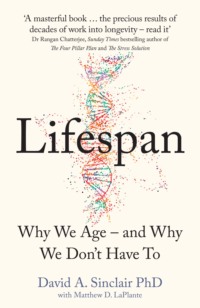
Полная версия
Lifespan
37
Though some cloned animals match their species’ rates of normal aging, it’s a field that still needs further analysis to get beyond the largely anecdotal evidence so far collected. J. P. Burgstaller and G. Brem, “Aging of Cloned Animals: A Mini-Review,” Gerontology 63, no. 5 (August 2017): 417–25, https://www.karger.com/Article/FullText/452444.
38
University of Bath researchers found in cloned mice that the telomeres protecting the ends of chromosomes were, surprisingly, slightly longer in successive generations and demonstrated no evidence of premature aging. T. Wakayama, Y. Shinkai, K. L. K. Tamashiro, et al., “Ageing: Cloning of Mice to Six Generations,” Nature 407 (September 21, 2000): 318–19. “Despite the length of telomeres reported in different studies, most clones appear to be aging normally. In fact, the first cattle clones ever produced are alive, healthy, and are 10 years old as of January 2008”; “Myths About Cloning,” U.S. Food & Drug Administration, August 29, 2018, https://www.fda.gov/animalveterinary/safetyhealth/animalcloning/ucm055512.htm.
39
The authors discovered mitochondrial DNA in a Neanderthal bone in Croatia that revealed older dates of survival than previously thought. T. Devièse, I. Karavanié, D. Comeskey, et al., “Direct Dating of Neanderthal Remains from the Site of Vindija Cave and Implications for the Middle to Upper Paleolithic Transition,” Proceedings of the National Academy of Sciences of the United States of America 114, no. 40 (October 3, 2017): 10606–11, https://www.ncbi.nlm.nih.gov/pubmed/28874524.
40
A. S. Adikesevan, “A Newborn Baby Has About 26,000,000,000 Cells. An Adult Has About 1.9 × 103 Times as Many Cells as a Baby. About How Many Cells Does an Adult Have?,” Socratic, January 26, 2017, https://socratic.org/questions/a-newborn-baby-has-about-26-000-000-000-cells-an-adult-has-about-1-9-10-3-times-.
41
C. B. Brachmann, J. M. Sherman, S. E. Devine, et al., “The SIR2 Gene Family, Conserved from Bacteria to Humans, Functions in Silencing, Cell Cycle Progression, and Chromosome Stability,” Genes & Development 9, no. 23 (December 1, 1995): 2888–902, http://genesdev.cshlp.org/content/9/23/2888.long; X. Bi, Q. Yu, J. J. Sandmeier, and S. Elizondo, “Regulation of Transcriptional Silencing in Yeast by Growth Temperature,” Journal of Molecular Biology 34, no. 4 (December 3, 2004): 893–905, https://www.ncbi.nlm.nih.gov/pubmed/15544800.
42
It is one of the most interesting and important papers I’ve ever read. C. E. Shannon, “A Mathematical Theory of Communication,” Bell System Technical Journal 27, no. 3 (July 1948): 379–423, and 27, no. 4 (October 1948): 623–66, http://math.harvard.edu/~ctm/home/text/others/shannon/entropy/entropy.pdf.
43
Research by the authors showed that mTORC1 signaling in cancer cells increases survival by “suppressing endogenous DNA damage, and may control cell fate through the regulation of CHK1.” X. Zhou, W. Liu, X. Hu, et al., “Regulation of CHK1 by mTOR Contributes to the Evasion of DNA Damage Barrier of Cancer Cells,” Nature Scientific Reports, May 8, 2017, https://www.nature.com/articles/s41598-017-01729-w; D. M. Sabatini, “Twenty-five Years of mTOR: Uncovering the Link from Nutrients to Growth,” Proceedings of the National Academy of Sciences of the United States of America 114, no. 45 (November 7, 2017): 11818–25, https://www.ncbi.nlm.nih.gov/pmc/articles/PMC5692607/.
44
E. J. Calabrese, “Hormesis: A Fundamental Concept in Biology,” Microbial Cell 1, no. 5 (May 5, 2014): 145–49, https://www.ncbi.nlm.nih.gov/pmc/articles/PMC5354598/.
45
Up to 69 percent of the human genome may be repetitive or derived from endogenous viral DNA repeats, compared to previous estimates of around half. A. P. de Konig, W. Gu, T. A. Castoe, et al., “Repetitive Elements May Comprise over Two-thirds of the Human Genome,” PLOS Genetics 7, no. 12 (December 7, 2011), https://www.ncbi.nlm.nih.gov/pmc/articles/PMC3228813/.
46
Just what do we mean by the word finished when it comes to the sequencing of the human genome? Turns out, more than we thought back in the early 2000s. Regions of the genome previously thought of as nonfunctional are now emerging as playing potential roles in cancer, autism, and aging. S. Begley, “Psst, the Human Genome Was Never Completely Sequenced. Some Scientists Say It Should Be,” STAT, June 20, 2017, https://www.statnews.com/2017/06/20/human-genome-not-fully-sequenced/.
47
Dating back to the 1960s, every three or four years the center has published a catalog of its strains of Saccharomyces cerevisiae. R. K. Mortimer, “Yeast Genetic Stock Center,” Grantome, 1998, http://grantome.com/grant/NIH/P40-RR004231-10S1.
48
Yeast researchers have interesting names. John Johnston and my adviser Dick Dickinson are just two of them.
49
In 2016, Dr. Yoshinori Ohsumi won the Nobel Prize in Physiology or Medicine for his work on autophagy in yeast. That’s when cells stave off extinction during hard times by digesting nonkey parts of themselves. B. Starr, “A Nobel Prize for Work in Yeast. Again!,” Stanford University, October 3, 2016, https://www.yeastgenome.org/blog/a-nobel-prize-for-work-in-yeast-again.
50
Dawes’s delightful tour of his experiences in the world of academe and cell biology research is a refreshingly direct and personal account of a remarkable journey into yeast research over four decades. I. Dawes, “Ian Dawes—the Third Pope—Lucky to Be a Researcher,” Fems Yeast Research 6, no. 4 (June 2016), https://academic.oup.com/femsyr/article/16/4/fow040/2680350.
51
I also learned, the hard way, that I should not drink copious quantities of yeasty beer.




